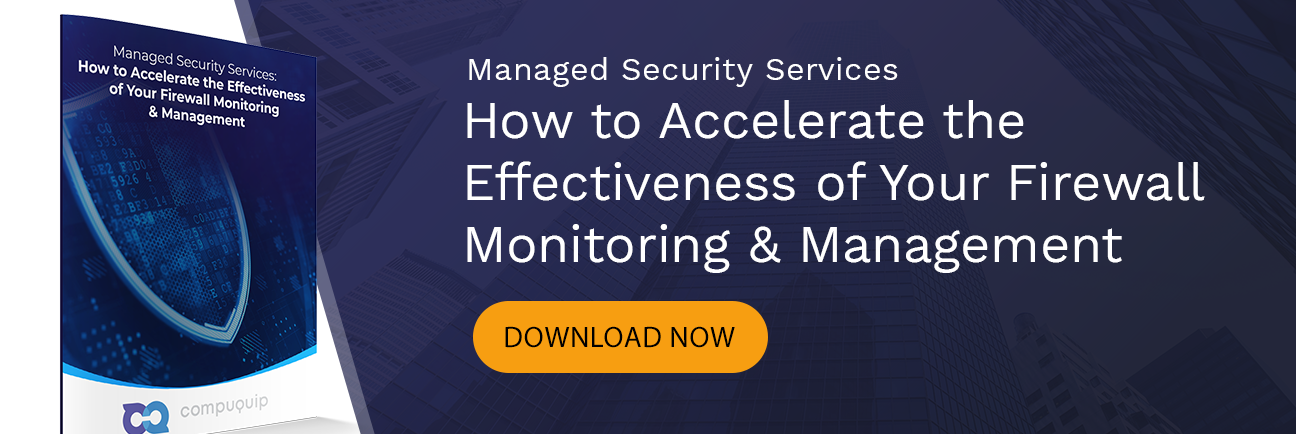5 Firewall Monitoring Best Practices to Adopt
Having strong firewalls is a basic requirement of business cybersecurity. To get the most out of their firewalls, organizations need to follow firewall management best practices such as deploying multiple firewalls to create defense-in-depth that slows down insider attacks.
Firewall monitoring is a crucial tool for optimizing existing firewall deployments in organizations of all sizes. However, many organizations neglect to track their firewall performance metrics and status until it is too late.
To help you improve your firewall management, here are a few firewall monitoring best practices for your organization to adopt:
Firewall Monitoring Best Practice #1: Use Firewall Monitoring Tools
Before you can start monitoring the effectiveness of your firewalls, you need some kind of firewall monitoring tool. These tools can be used to keep track of data such as current rule configurations, alerts, and event logs (event logs are typically built into the firewall, but a monitoring tool can help users efficiently parse this information).
Without some form of firewall monitoring tool, it is more difficult to make informed decisions about firewall management and rules configurations. In particular, being able to keep track of current rules configurations is critical for being able to identify obsolete firewall rules that need to be removed (or at least modified).
This is why having monitoring tools is one of the most basic, but important, firewall security best practices to follow. Some organizations even choose to outsource their firewall monitoring to a managed security services provider to act as a firewall monitoring service.
Firewall Monitoring Best Practice #2: Track All Firewall Rules Changes
This is a firewall rules best practice in addition to being a firewall monitoring best practice. As noted by Network World, “firewalls do not have a change management process built into them.” Because they lack a built-in solution for tracking rules changes, many IT admins responsible for managing firewalls do not document these changes—especially if they’re under the gun to make changes quickly in response to new developments.
However, there is a risk that any new rules change may cause a conflict with a business process or other firewall rule. This can lead to downtime as the IT team has to review all of the current rules against different business processes to see what broke and why.
By tracking changes as they’re made and compiling them into a change history document, the culprit behind the workflow interruption is easier to identify and fix.
Firewall Monitoring Best Practice #3: Keep an Eye Out for “Rule Bloat”
Over time, a business’ work processes and tools may change. Firewall rules configurations need to change with them. When an old service, business process, or resource is discontinued, there may still be rules in the firewall configuration that are designed for them. This increases the odds of rules conflicts and, as noted by Network World, “Hackers like the fact that firewall teams never remove rules. In fact, this is how many compromises occur.”
Using a firewall monitoring tool to check for old and obsolete rules (and then eliminating those rules) is key for optimizing firewall management. This may require the IT team to coordinate with the business unit to identify when a particular business process, service, or resource is discontinued so they can remove any associated rules as needed.
Firewall Monitoring Best Practice #4: Periodically Audit the Firewall Event Log
According to esecurityplanet.com, one firewall best practice is to audit event logs “to look for changes or anomalies that might suggest modifications to your firewall settings.” Checking the event log in this way can be used to:
- Help identify which rules are being triggered the most frequently;
- Find “false positives” for traffic that interacts with security rules, but shouldn’t be;
- Identify security rules that aren’t being triggered at all; and
- Provide data useful for modifying firewall settings/rules.
Having a firewall monitoring tool that uses machine learning algorithms to identify patterns in the event logs can help save time and improve firewall rules management. This is why audits are crucial for following firewall rules best practices.
Firewall Monitoring Best Practice #5: Have the Firewall Manager Meet with the Business Unit
From time to time, the firewall manager should meet with the business unit to get information and updates about the business and its operations. This way, the firewall manager can stay on top of important changes and make alterations as needed. For example, if the business unit discontinues a service or makes changes to a business process workflow, the person or team managing the firewall might need to adjust the firewall’s configurations to improve network efficiency.
By holding monthly or quarterly meetings with the business unit, the IT team can help ensure that they’re aware of major changes in the organization. This, in turn, is invaluable for improving their firewall management.
Need more help and advice about firewall monitoring and management? Reach out to the Compuquip team today to learn more.

